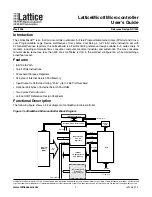
eCS400 | Issue 2 (H13F) 20/04/18
Original Language Version
© Jack Sealey limited
6.1.2.
start mode.
To start a vehicle with a flat battery, this mode consists of the following steps:
• STEP 1: Battery analysis: The charger’s Start LED flashes.
• STEP 2: Fast Charging: The charger enters this step if the Start LED is steadily on. It sets the charge end voltage associated with the
selected battery type with the current limit defined for the Start step.
• STEP 3: Engine Boost: When the battery charger detects an engine cranking attempt, it switches to the next step. If the battery
voltage reading is above 13.5V the scrolling message START appears on the display.
• STEP 4: Boost: The scrolling message START appears on the display: the battery charger is now delivering the maximum power.
6.1.3.
supply mode.
Power supply mode to assist in vehicle programming. This mode does not contain any charging steps, and it consists exclusively of a
stabilised power supply delivering the nominal battery voltage. The purpose is that of supplying current to support the battery to prevent
it from being drained during operations that require power for short or long periods.
6.1.4.
recovery mode
.
Warning
: because of the high voltage reached during this cycle, the battery recovery process muST be performed with the battery
disconnected and removed from the vehicle. Recovery with the battery connected to the vehicle may result in damage to the
vehicle’s electronics.
This is the method of recovery for sulphated batteries accessible by means of a prolonged press of 3 seconds of the Function button.
The screen displays the message ReCoVeRY alternating with the instantaneous voltage or current reading; during this step the
Charge LED flashes.
The charger performs a special charging cycle in which higher than average voltages are forced to attempt recovery of the battery. In
this mode no error messages are generated during the charging cycle.
At the end of the cycle a message is displayed to indicate whether or not the battery has been recovered on the basis of the current
absorption.
This mode has six steps as described below:
• STEP 1: Analysis 1: Outputs below 1.5V will cause the device to revert to standby.
• STEP 2: Desulphation: Pulsed voltage in order to prevent sulphation of the battery.
• STEP 3: Controlled Current: Charges the battery up to the programmed limit value.
• STEP 4: Deep Cycle Charging: Central Charging Cycle.
• STEP 5: High Voltage: Keeps the battery at high voltage for 2 hours to attempt to break down the sulphate crystals that have
formed in the battery.
• STEP 6: Analysis 2: Checks whether or not the battery has been recovered.
6.2.
charging mode:
6.2.1.
Set Capacity.
Preset charging bands to select the connected battery, or for expert users, manual setting of the output current as a percentage of the
maximum current supported by the operating mode currently selected on the battery charger manual Current Setting.
Specifically:
• Charge: settable charging band.
• Start: settable charging band.
• Supply: Settable supply band, by Manual Current Setting.
Charge 4Ah - 550Ah (manual).
Supports all batteries from a minimum of 4Ah up to a maximum of 550Ah.
.
output current is adjustable from 0 up to the maximum supported by the operating mode currently selected on the battery charger.
Charge 150Ah - 300Ah.
.
Supports batteries from 150Ah up to 300Ah. output current adjusted automatically.
Charge 80Ah - 150Ah.
Supports batteries from 80Ah up to 150Ah. output current adjusted automatically.
Charge 30Ah - 80Ah.
Supports batteries from 30Ah - 80Ah. output current adjusted automatically.
6.3.
Battery type.
Wet: Acid electrolyte batteries.
Agm-Spiral Cell:AGM batteries with flat plate or Optima type spiral cell.
6.4.
saving settings.
The battery charger saves the settings made on the control panel. In the event of an accidental power loss or voluntary power off,
when the charger is restarted, it will restart with the latest saved settings, including the Start/Stop status
6.5.
Battery analysis.
The analysis stages within the operating modes may terminate with the signalling of various errors:
• Damaged Battery: the Fault LED switches on and the Start/Stop LED switches off and the charger enters Standby mode.
The display shows the message errxx where xx is the number corresponding to the cause of the error (see table). Single 10 second
audible warning.
• Polarity reversal: the Reverse LED switches on and the display shows the message Err07 with a two second audible warning.
• Analysis step in: Charge: the display shows the scrolling message ANALYSIS alternating with the measured voltage or current
value; the LED corresponding to the function continues to flash until the analysis is concluded. If the battery is in good condition, the
led will be on, otherwise the display shows scrolling message SulPHATed BATTeRY and an intermittent audible warning is emitted.
• Analysis step in: Start: in the preliminary analysis function in Start, the LED of this mode will flash until a current absorption
exceeding a minimum threshold is detected, after which the led remains on and the vehicle engine can be started.
























